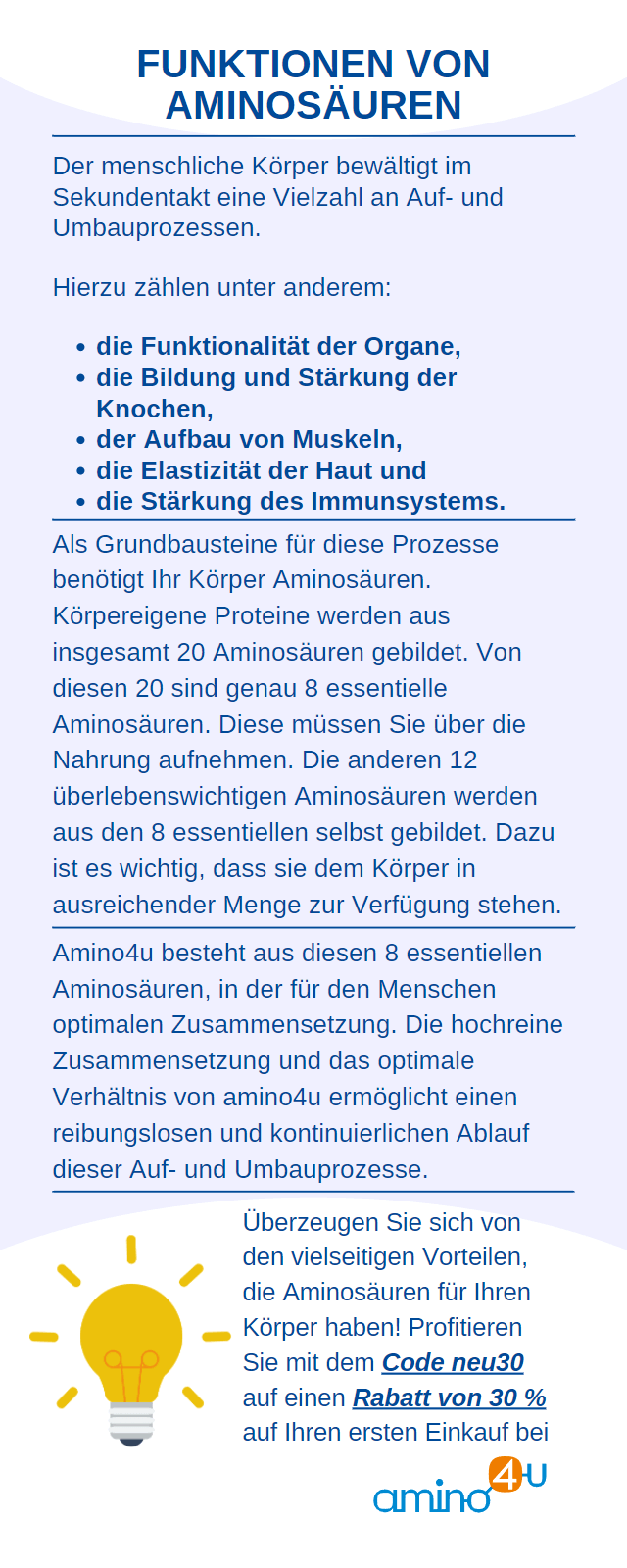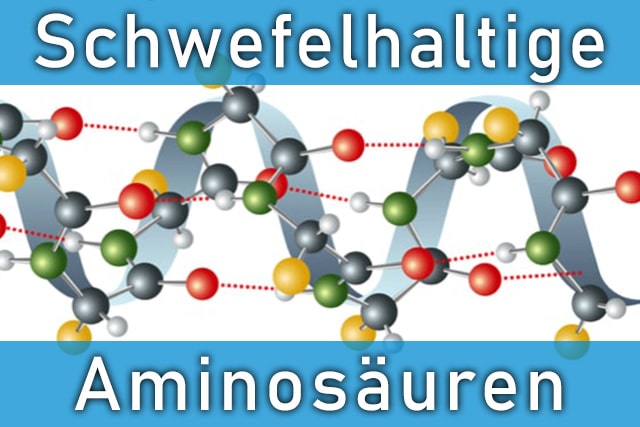You've probably heard about amino acids and their importance for our health. Perhaps you have even had one or two personal experiences with a particular amino acid. This could have been while exercising or dieting.
Anyone who is interested in nutrition is always learning new things on the subject. Nutrition experts, scientists and doctors are working intensively on aminos.
We have summarized the basic current findings for you here.
Amino acids - what do we mean by them?
When chemists and biochemists talk about amino acids, they primarily emphasize the common chemical structure of this class of substances. All representatives of this group of substances have at least two carbon atoms. Carbon forms the basis of most chemical compounds on Earth.
Through the aminos as building materials, it also forms the essential
basis of our body tissue .
This is what makes all of life on earth possible. Animal and plant life is fundamentally based on building blocks that contain these specific carbon atoms. These are certain
representatives of the amino acids .

Many of the aminos form long chains that are branched or straight and form the
basis of protein . Protein is also known as egg white. You probably know protein as one of the three macronutrients, along with carbohydrates and fats. Many of our foods contain protein in one form or another.
However, that does not mean that all foods contain protein building blocks in sufficient quantities and in an appropriate combination.
Particularly long chains among the aminos form special proteins -
the peptides . We will also get to know a trio of branched-chain building blocks later. They are particularly interesting for athletes.
The building material of life - the genetic code
Amino acids are known as the building materials of the human body. But their functions and their meaning go far beyond that. For example, 20 amino acids are hidden
in our DNA as genetic code.
You probably know that our body cells contain genetic information in a certain structure. When cells divide, they pass this information on to subsequent cells. You can think of the whole thing as a kind of blueprint.
The carrier for this genetic information is DNA. This abbreviation stands for the complicated name
deoxyribonucleic acid , or the English name deoxyribonucleic acid.
Anyone who takes a closer look at the topic
of genetic information quickly asks themselves how the cells can read this information. In other words: How do the cells know which tissue forms they need to form in individual cases?
Hidden on individual sections of DNA - in the genes - there are references to 20 amino acids. This happens through a certain genetic code. We humans are now able to read this code. We keep coming across the
20 special amino acids in different combinations.
These 20 special representatives of aminos are
proteinogenic amino acids . They are also known as protein building blocks. They are the smallest building blocks of protein. This is reflected in the additive proteinogenically.
Our entire body tissue and thus
our entire physical existence is made up of them. The importance of these building blocks is not limited to human existence. Each amino acid in this group shapes all animal and plant life. This information already makes it clear what an indispensable role protein building blocks play.
The 20 basic building blocks are also known as standard amino acids.
Amino acids overview
Aminos are categorized according to different aspects.
The
20 standard proteinogenic amino acids are:
- Alanine
- Arginine
- Asparagine
- Aspartic acid
- Cysteine
- Glutamine
- Glutamic acid
- Glycine
- histidine
- Isoleucine
- Leucine
- Lysine
- Methionine
- Phenylalanine
- Proline
- Serine
- Threonine
- Tryptophan
- Tyrosine
- Valine

Constant conversion processes and variety of functions
The aminos are not just the building materials of body tissue. Together with other building blocks and various micronutrients, they perform countless other functions in the human organism. They shape large parts of metabolic functions.
They also convert into other substances such as messenger substances. Another characteristic feature of all amino acids is that they are consistently subject to conversion processes. The
formation of the body's own protein is also such a conversion process.
This dynamic, especially with standard amino acids, often leads to the highly simplistic and non-scientific statement that
amino acids proteins - unlike carbohydrates or fats - supply our organism with less energy than they consume energy.
This statement is often associated with nutritional recommendations for protein in diets. We will see whether it contains a core of truth when it comes to the topic of nutrition and diet.
-
Essential building block types - overview of amino acids
The human organism can produce some of the protein building blocks mentioned itself from other amino acids and substances. In contrast
, eight representatives of this group form the association of the so-called essential amino acids.
They must be taken in with food. We cannot form them independently in the body.
Essential amino acids are:
- leucine,
- isoleucine,
- phenylalanine,
- methionine,
- lysine,
- threonine,
- Valine and
- Tryptophan.
-
Non-essential and semi-essential building block types
In contrast to the essential protein building blocks, the building blocks we form ourselves are called
non-essential amino acids .
Semi-essential amino acids are located in an intermediate area. They are essential in some phases of life, but not in others.
This applies, for example, to arginine. This building block can be essential in adolescence.
The essential protein building blocks can be particularly well absorbed and utilized by the human organism. This led the American scientist
Professor Luca-Moretti to speak of the human amino acid pattern in connection with these protein building blocks.
In his opinion, every living being has a
specific amino acid pattern . This is formed from protein building blocks, which are particularly good for building up the body's own protein in every living being.
The amino acid pattern differs from living being to living being.
This assessment by Luca-Moretti underlines the importance of a well-composed diet. Above all, this must ensure a constant supply of essential amino acids.
-
The ketogenic group
Another interesting subgroup within the standard amino acids are the
ketogenic protein building blocks .
The six building blocks
- leucine,
- lysine,
- phenylalanine,
- isoleucine,
- Tryptophan and tyrosine
are represented here. We will see that these amino acids can support certain diets and diets. They play a key role in a special form of metabolism in which fats in particular are converted into energy.
Normally our body gets energy from sugar and therefore carbohydrates.
-
L and D shapes
You may have already noticed: in descriptions of aminos we often find a capital L in front of the name of the building block. The building blocks can take on different structures in which their components are distributed either to the right or to the left.
A distinction is made between
L and D structures for the building blocks. Both forms are basically the same structure, but behave in a mirror-inverted manner to each other. When we talk about protein building blocks here, we usually mean the L-form.
Experts are not yet sure what function the D-structures actually have. So far it seems that L-structures produce more intense effects than the D-shapes.
Functional areas and benefits
We already know that protein building blocks form the basis of all body tissue. However, in interaction with other substances, they affect many other physical areas. Among other things, our nervous system, the health of our blood vessels and many other functions depend on them.
This also means that we can specifically influence certain areas of the body with one or another amino acid. From a scientific perspective, there are still some unanswered questions in this topic. Nevertheless, there are already a number of findings about the
physiological connections .
The standard amino acids became particularly interesting to scientists as they continued to understand the fundamentals of genetic information in the mid-20th century. Since then, scientific studies and reports have expanded knowledge on the topic.
All of this information can be used to identify functional areas in our body that could benefit from additional intake of one or another amino acid.

Basic information about needs and possible shortages
Before we turn to individual functional areas, let's look at the daily need for building blocks. It is difficult to make standardized statements about the amounts of protein building blocks each person needs per day.
Since only the standard amino acids need to be consumed with food, the
World Health Organization (WHO) has developed recommendations for the daily intake of these protein building blocks.
She recommends these
daily intake levels in milligrams per kilogram of body weight:
| amino acid |
mg/day |
| Phenylalanine |
25 |
| Leucine |
39 |
| Methionine |
15 |
| Lysine |
30 |
| Isoleucine |
20 |
| Valine |
26 |
| Threonine |
15 |
| Thryptophan |
4 |
From these recommendations it can be seen that the needs vary from person to person. They
depend, among other things, on body weight .
Variable needs
But the needs can also vary:
- according to the level of physical activity.
- with stress and special external influences such as UV radiation.
- in old age.
- in special life situations.
- with calorie-reduced diets and special forms of nutrition.
As a rule, the demand will increase under any kind of stress. Since the WHO recommendations only consider the essential building blocks, there is no overall picture of the supply of
amino acids .
It is difficult to determine whether the formation of non-essential amino acids occurs to a sufficient extent. There are other factors at play here. Some non-essential protein building blocks rely on other substances and micronutrients for their formation. These must also be available in sufficient quantities at all times and, above all, at the same time.
How do you recognize an amino acid deficiency?
A
deficiency in the valuable protein building blocks can occur hidden and go unnoticed for a long time.
Since protein building blocks are active in many physical areas, the
amino acid deficiency symptoms are often vague, especially at the beginning.
You can from
- states of exhaustion,
- inner restlessness and poor sleep
- about skin problems as well
- the breakdown of the body's own muscles.
Another problematic factor is that many doctors are unable to delve deeper into nutrition and protein building blocks.
Sports physicians and experts in orthomolecular medicine may well be able to assess the importance of aminos for our health. Orthomolecular medicine specialists deal intensively with nutrients and microsubstances.
This does not necessarily have to be the case with a general practitioner. A lack of knowledge is understandable, as these are very
complex and specific contexts . In addition, even experts in the field of nutrition do not agree on many issues.
More awareness of the
importance of amino acids , but also of vitamins and trace elements, is only gradually growing.

Intake through daily food
When discussing building blocks and nutrition, surprising controversies often arise.
Some nutrition experts vehemently complain that the typical diet of modern people contains far too much protein. Others, however, are of the opinion that we often suffer from a protein deficiency without noticing. This controversy arises, among other things, because experts often do not talk about the same topic.
We can
eat a diet rich in protein and still not consume one or two amino acids in sufficient quantities.
It's just not the protein itself that's interesting. What is more relevant is the protein building blocks in combination, especially the essential representatives that form the basis for the body's own protein.
How can you promote a complete amino acid pattern?
For example, many plants contain significant amounts of protein. Almond flour has a
protein content of 56% . That's only one percent less protein than smoked salmon.
However, if we take a closer look, one or two building blocks that would completely represent the series of essential protein building blocks are often missing. When it comes to essential representatives of protein building blocks, some
animal foods have a clear advantage.
The picture that emerges here is that the complete amino acid pattern is depicted with all essential building blocks.
However, not all nutrition experts support the consumption of larger amounts of animal protein. Some time ago, the WHO issued a warning against
excessive consumption of red meat .
There are still many questions unanswered here. Some people also reject the consumption of animal products for ideological reasons.
Which foods are particularly high in protein?
The
German Society for Nutrition recommends that the diet contains at least
15-20% protein per day.
This corresponds to a value of 0.8 g protein per kilogram of body weight for a healthy adult. In other words, nutrition experts estimate that an adult man needs an average of 60-70 g of protein and that of an adult woman around 50 g of protein.
Certain life circumstances can significantly increase this need. It is estimated that athletes need up to 1.8 g/kg of body weight. This applies equally to strength and endurance athletes.
In addition to meat and dairy products, the following are particularly
rich in protein :
- eggs,
- soy flakes,
- pumpkin seeds,
- Tuna,
- hemp seeds,
- Red lenses,
- Cashews.

Value of protein
When it comes to plant-based protein sources, the so-called
biological value must be taken into account. It is a measure of how effectively our body can convert ingested protein into the body's own protein.
The theory of amino acid patterns also takes up this aspect. The human organism converts the essential amino acids into the body's own protein particularly well.
If we look at protein sources from animal and plant foods, plant-based foods generally perform worse in terms of value.
For vegans and vegetarians, for example, this means that they have to carefully put together their diet. You can achieve sufficient
intake of high-quality protein through combinations of certain foods.
Where and how positive effects can be seen
Each amino acid fulfills a variety of tasks in the human organism. The protein building blocks, but also other representatives of the amino acids, can therefore have an impact on a wide variety of areas.
Get to know some important building blocks in the following sections. You may also find a suggestion for natural support here if you are having problems in any of these areas.
-
Aminos for sleep disorders
Anyone who suffers from nervous tension and/or sleep disorders often looks for natural alternatives to help.
The amino acid tryptophan may be able to do something for you in this area.
This essential building block contributes to the
formation of the messenger serotonin in the human body. Serotonin, for its part, is closely linked to our nervous calm and healthy, deep sleep. The precursor to serotonin, tryptophan, is considered a type of natural antidepressant in itself.
It is interesting to know that L-tryptophan is able to cross the blood-brain barrier. If you consume
amino acids for sleep disorders , you can improve your sleep quality.
How tryptophan best gets into the brain
This means that tryptophan can penetrate directly
into the brain's nutrient fluid . There it is not only the precursor for the messenger serotonin, but also for
melatonin . You probably know that melatonin is directly linked to the quality of our sleep.
If you would like to specifically increase L-tryptophan levels with certain foods, you should know another special feature of this amino acid. When absorbed into the brain, it competes with various other protein building blocks.
By combining protein-rich food with carbohydrates, we give L-tryptophan an advantage in absorption.
This results in the observation, for example, that hot milk with honey in the evening can promote healthy sleep. The honey adds carbohydrates (sugar) to the protein-rich milk. This leads to an increased release of insulin.
The hormone insulin diverts certain other building blocks that compete with L-tryptophan into the muscles. This clears the way for L-tryptophan to
overcome the blood-brain barrier .
Anyone who is interested in tryptophan should also pay attention to the following phenomenon: Stress can lead to an increased
breakdown of L-tryptophan via the release of the stress hormone cortisol. Here the need for this essential building block can increase quickly.
Tryptophan can have side effects
Also important : In high doses, L-tryptophan can cause side effects such as, among others
- dizziness,
- feeling dizzy,
- nausea and
- cause headaches.
L-Tryptophan is sometimes used as a medicine for sleep disorders. Dosages of 0.5 g to 1 g are recommended.
If you use it yourself, you should stick to the lower dosage. Caution is advised if certain medicines such as so-called
MAO inhibitors for depression are taken at the same time. These medications increase serotonin levels.
L-tryptophan can
increase the effects of these medicines . This can lead to an excess of serotonin. This can be life-threatening under certain circumstances.
-
Amino acids for skin, hair and connective tissue
Do you also want to stay
wrinkle-free for as long as possible as you get older ? Maybe some protein building blocks can help you.
Since protein building blocks are the basis of every body tissue, our skin, but also other body structures, depend on an adequate supply of protein building blocks.
For example, the
fiber structure collagen is particularly important for the strength and smooth, external appearance of our skin.
As we get older, the ability of physical structures to regenerate gradually decreases. Factors such as free radicals - these are aggressive and binding oxygen molecules - now have a more intense effect.
The result is, among other things, an increased tendency of the skin to form wrinkles. Some protein building blocks can help you counteract premature wrinkle formation or hair loss. Which
amino acids can work against hair loss ?
These are above all
- Arginine with its potential impact on the vascular structure and blood flow in the skin
- Histidine with possible skin-soothing properties
- Methionine as protection against harmful factors from the environment
-
Lysine as a strengthening substance for skin and hair
- Leucine, glycine and proline are amino acids that fight wrinkles and support cell regeneration
Not all possible effects of protein building blocks have been scientifically proven. However, the examination of individual protein building blocks speaks for itself.

-
Fat metabolism and cholesterol levels
The amino acid arginine can reduce cholesterol levels by up to 10%. A
scientific study came to this conclusion in 1995.
The building block taurine, which is formed from cysteine and methionine, can also contribute
to protecting the entire cardiovascular system . It also has a positive effect on cholesterol levels and blood pressure. It may therefore be possible to lower
cholesterol with amino acids .
-
Can you lose weight with amino acids?
Have you ever had to deal with the infamous yo-yo effect while on a reduction diet?
Proteins and protein building blocks are closely linked to the yo-yo effect. If you don't give your body enough protein during a diet, the organism will begin to break down the body's own protein from the muscles. This means your diet is programmed for failure from the start.

The yo-yo effect and the breakdown of muscles
Your muscles burn most of the energy in your body. If it is reduced during the diet, you will burn fewer calories. When you stop your calorie restriction and return to a higher calorie intake, your body will burn fewer calories than before the diet.
In other words, they need fewer calories because they have less muscle.
We probably all know the result of the yo-yo effect: we quickly weigh more after the diet than before. How can you
lose weight with amino acids ?
It is important that you ensure that you consume sufficient and rather additional amounts of standard amino acids when on a reduction diet. As far as the specific amount is concerned, you should at least consume the WHO recommended values for essential amino acids.
Your individual needs during a diet may even be higher than these recommended values. Dieting also places a kind of stress on your organism.
-
Metabolic change with protein
But maybe you can even change your entire metabolic activity with the help of a few protein building blocks?
We have already introduced you to
ketogenic amino acids above.
You may know that the human organism normally
gets its energy from sugar . Sugar here also stands for carbohydrates, which are complex sugars. Our brain in particular uses a lot of energy and therefore a lot of sugar.
The production of energy from carbohydrates and the associated processes in the liver involving insulin can contribute to weight gain. Today we regularly consume large amounts of starchy complex carbohydrates such as bread, pasta, potatoes or rice.
What is less known to most people is that there is another way to generate energy.
Ketogenic metabolism
Our organism can be made to obtain its energy from fats in a complex process. The so-called
keto diet is based on this process of metabolic change. The organism must be programmed to change its metabolic activity by reducing carbohydrate intake.
This requires the formation of structures that we call
ketone bodies . The ketogenic protein building blocks form ketone bodies. They can therefore be used to support a keto diet.
So when following a ketogenic diet, be sure to remember the building blocks leucine, lysine, phenylalanine, isoleucine, tryptophan and tyrosine.
By the way : A ketogenic metabolism uses a lot of energy. The claim that protein requires energy to metabolize is also based on this effect.
-
Why do we need amino acids for building muscle and in sports?
BCAA - an abbreviation that almost all athletes probably know. Strength athletes in particular are convinced by this quartet of certain standard amino acids. BCAA stands for the English expression “
Branched-Chain Amino Acids ” for
branched-chain amino acids . This refers to the three essential protein building blocks leucine, isoleucine and valine.
Among other things, they play a key role in
supplying energy to the muscles . Strength athletes take advantage of this effect by increasing their BCAA intake.
However, BCAAs can not only have an effect on pure muscle building. Endurance athletes also benefit from these three amino acids. Obviously, increased intake provides more energy to the muscles. This promotes endurance performance.
However, BCAA are not only interesting for competitive athletes or ambitious amateur athletes.
Older people can also support the
maintenance of their muscles through
regular, moderate exercise . We can already notice a tendency to muscle loss from the age of 30.
Studies also indicate that BCAA can keep body weight lower from middle age onwards.
Athletes - especially strength athletes - often also use the special properties of the amino acid arginine. The next section deals with the blood circulation-promoting properties of this protein building block.
-
Amino acids and potency
The
semi-essential amino acid arginine is the focus of attention here. Erectile dysfunction affects many men at different ages. Classic erectile dysfunction occurs particularly in conjunction with cardiovascular diseases and changes in men's blood vessels.
This means that erectile dysfunction can also be caused by serious illnesses such as diabetes mellitus, high blood pressure and arteriosclerosis (calcification of the arteries).
In addition, there is the psychological stress caused by the
lack of sexual performance in cases of erectile dysfunction. Medicines that treat erectile dysfunction are often associated with severe side effects. The highly effective PDE-5 inhibitors (e.g. Viagra) are therefore not without controversy.
Since it is estimated that over 50% of all men aged 40 and over can be affected by erectile dysfunction, many sufferers are looking for natural alternatives.
The amino acid L-arginine is very
effective against erectile dysfunction . The protein building block has an essential function in the formation of nitric oxide in physical tissues. Nitric oxide ensures, among other things, that muscles and blood vessels relax.
A man's erectile function is based in particular on the fact that there is a
sufficient flow of blood into the erectile tissue of the penis. Arginine ensures this necessary relaxation via the nitric oxide cycle and at the same time prevents the backflow of blood.
As a result, erectile function can be effectively promoted. The PDE-5 inhibitors also use the effect of increased blood flow into the erectile tissue. But they use a different mechanism.
L-arginine could therefore be a
side-effect-free alternative against erectile dysfunction.
-
Other areas of application such as high blood pressure, tinnitus, psyche and menopause
The amino acid arginine in particular occupies a special position among the aminos. Positive effects are also described for
high blood pressure , diabetes, tinnitus and supporting the human immune system.
Women going through
menopause can benefit from arginine.
Hot flashes, for example, can potentially be positively influenced here. L-arginine works particularly well when the amino acid lysine is present in sufficient quantities. Lysine ensures that arginine is better absorbed into the body's cells.
The
stability of the bones also benefits from lysine. The protein building block increases calcium absorption in bone tissue. This could make it easier for menopausal women to prevent bone softening (osteoporosis).
We have already learned about the amino acid tryptophan above, which, among other things, affects our nervous system. Another interesting building block in this context is tyrosine.
Tyrosine for the psyche, thyroid and the effects of stress
Tyrosine is not an essential amino acid. The precursor to this building block is phenylalanine. Phenylalanine is essential for the human organism.
Tyrosine is essential for a wide range of tasks and functions in the body. Among other things, this building block forms the precursor for messenger substances such as dopamine. The so-called
stress hormones adrenaline and norepinephrine are also formed from tyrosine.
This building block is also considered a precursor to thyroid hormones. A lack of tyrosine can therefore manifest itself in the form of many complaints, including depressive moods.
Studies indicate, among other things, that tyrosine can be used specifically to
mitigate the effects of stress .

Who needs aminos and benefits from nutritional supplements?
We have already seen that the need for high-quality aminos varies from person to person. This depends on a person's specific living conditions and overall health situation.
A sufficient
supply of high-quality proteins should primarily include the amino acids that are essential for the human organism. However, the need for individual amino acids can be increased, for example in athletes, in old age or in special stressful situations.
Certain groups of people have emerged who generally benefit particularly from the additional supply of high-quality aminos.
Vegetarians and vegans
Due to the higher value of animal protein
, essential amino acids are particularly interesting for vegans and vegetarians.
You should pay particular attention to the composition of your diet and
protein intake . In particular, if additional stress is added, such as intensive sporting activity or stress, the needs of this group of people can increase further.
A nutritional supplement with
high-quality amino acids may be a good decision here.
Seniors
Older people face many physical changes. Many of them struggle with obesity, changes in metabolic functions and other diseases. The
need for valuable amino acids usually increases with age.
This is partly because many physical functions no longer function as smoothly and quickly as they did when we were younger.
Experience reports suggest that older people could benefit from an additional supply of high-quality aminos. One or two individual building blocks such as L-arginine could also help you feel healthier and fitter as you age.
Women in menopause
As described, L-arginine, for example, can help women during
menopause to better cope with hot flashes and other negative symptoms. In menopausal women, the changed hormonal situation also makes it important to prevent decalcification of the bones and cardiovascular diseases.
The female sex hormone estrogen protects women to a certain extent, for example from cardiovascular problems, until they reach menopause. If this protection fails due to the lack of estrogen, women could build up new protection with L-arginine.
Furthermore,
sufficient intake of essential aminos can also help you feel youthful and beautiful for longer.
Athletes and high achievers
We could see that the need for high-quality proteins is increased in athletes. This is why this group of people in particular depends on a sufficient supply of amino acids. Aminos should not only play a key role in the diet.
Supplementation can, under certain circumstances, help to cope with performance peaks and high physical stress.
People who have to do a lot in their everyday lives and at work could also benefit from an additional supply of amino acids.
Dogs, cats and horses
In animals such as dogs, cats and horses, additional high-quality aminos can have positive effects.
Cats, for example, rely on high-quality protein in their diet. Cats are carnivores. They are significantly less tolerant of carbohydrates than dogs. Without an adequate supply of taurine - essential for cats - cats become seriously ill. You can go blind and have heart disease.
Dogs also benefit from high-quality protein.
In horses, amino acids can, among other things, promote muscle building.
Ingestion and dosage forms
Amino acid supplementation is possible through various
amino acid preparations . Athletes in particular know the common
(protein) powders and the
amino acid complex .
In addition, aminos can also be taken - as in our case - as
tablets or capsules.
Products with protein building blocks differ, among other things, in the biological value of the protein. We remember: Biological value refers to the extent to which supplied protein can be converted into the body's own protein.
Supplements with protein building blocks differ in the origin of the protein supplied.
There are also products that contain all the essential components of the building blocks. However,
nutritional supplements with just one or a small group of building blocks are also offered.

When should you take amino acids?
The time when you take it is just as individual as your needs. For athletes, it is often recommended
to take amino acids before training, but also after training to promote muscle building.
There are products that promise a particularly quick transition into the blood. Here it is recommended to take it before a meal.
Are there one or two components that have a negative effect?
You may have heard of homocysteine before. This building block is not essential. It is formed from methionine.
Homocysteine does
not have a good reputation . In high concentrations, which are also reflected in increased blood values, this building block is suspected to damage the blood vessels. Other micronutrients such as vitamin B12 and B6 are said to be able to counteract this.
In this article on the topic of amino acids, we would also like to mention that not all building blocks per se only have positive effects in the human body.
Due to the constant conversion of aminos into other building blocks and substances, building blocks are often created that can have negative effects.
Research in this area is not yet complete. It is important that, in addition to a supply of high-quality protein building blocks, the supply of other vital micronutrients is also ensured.
Effects and side effects of amino acids
Amino acids can have side effects , especially when taken in isolation and in high doses. We saw this above with tryptophan, for example. It is generally important to note that excess proteins must be excreted via the kidneys. This puts a strain on kidney activity and can be a problem, especially if you have previous illnesses.
If you suffer from impaired kidney function, you should consult your doctor before taking additional protein.
Conclusion
The human organism is absolutely dependent on amino acids in many functional areas. This does not only apply to essential representatives of these substances. Protein building blocks not only influence our health, but also
our well-being .
It is therefore particularly worthwhile to ensure that you have a
sufficient supply of amino acids . This is particularly true in advanced age.
 Many of the aminos form long chains that are branched or straight and form the basis of protein . Protein is also known as egg white. You probably know protein as one of the three macronutrients, along with carbohydrates and fats. Many of our foods contain protein in one form or another.
However, that does not mean that all foods contain protein building blocks in sufficient quantities and in an appropriate combination.
Particularly long chains among the aminos form special proteins - the peptides . We will also get to know a trio of branched-chain building blocks later. They are particularly interesting for athletes.
Many of the aminos form long chains that are branched or straight and form the basis of protein . Protein is also known as egg white. You probably know protein as one of the three macronutrients, along with carbohydrates and fats. Many of our foods contain protein in one form or another.
However, that does not mean that all foods contain protein building blocks in sufficient quantities and in an appropriate combination.
Particularly long chains among the aminos form special proteins - the peptides . We will also get to know a trio of branched-chain building blocks later. They are particularly interesting for athletes.











